While George B. Adams is credited as the inventor of celluloid pinback buttons, there is another important inventor to discuss, one who has historically been relegated to a single line in celluloid pinback button history, Amanda M. Lougee.
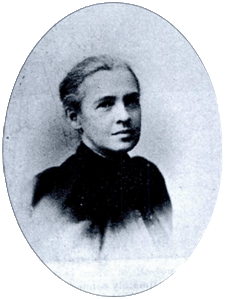
Amanda Melvina Lougee was born in 1842 in Walmouth, Massachusetts to Robert W. Lougee and Sarah Lougee. Defying gender expectations of her time, she became the head of a rubber-gossamer manufacturing plant in in Hyde Park, MA. After years of being her brother’s “silent partner,” she officially took over upon his death, rather than leave the business to strangers. Beginning with rubber-gossamer in 1879, she expanded the business into the manufacturing of double textured clothing, mould work, and electrical tape. By 1897, she employed over 275 people, and had opened up a factory in Clarendon Hills and offices in New York and Chicago. Her female contemporaries, on discussing her business leadership, stated that, “most men who deal with ‘A.M. Lougee, Treasurer,’ do so in total ignorance that they are dealing with a quiet little elderly woman” (Willard, Winslow, & White, 1897). Her feminist work went beyond her career; she was also active in the women’s suffrage movement. She had been an auditor for the Massachusetts Women’s Suffrage Association, treasurer for the Association of the Advancement of Women, treasurer for the National Council of Women, and Fruit Cake recipe contributor to the 1890 Woman Suffrage Cookbook.
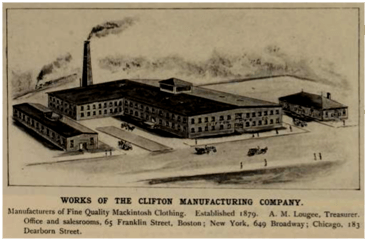
Not only was she an accomplished business person and active suffragette, she was also an inventor who held multiple patents. In the early 1900’s she was granted seven patents for electrical conduits, protected conductors, as well as fireproof fabric, fireproof wire, and fireproof conductors. But the patent that may be her most lasting and influential, is that of the covered button.
On July 17, 1894, Lougee was granted a patent for her covered button. While this is a cloth and metal button, the patent became integral to the creation of the first celluloid pinback buttons. While George B. Adams is credited with the first patent for celluloid pinback buttons, Lougee’s patent paved the way for the celluloid button to be created and in 1896, Whitehead & Hoag Co. purchased Lougee’s patent and began to manufacture the first celluloid buttons in the same year.
Whitehead and Hoag Co. was established in 1892 by Benjamin S. Whitehead and Chester R. Hoag. They began in Newark, NJ, and would go on to become one of the world’s largest manufacturers of advertising novelties. In 1896, they began production on the first celluloid pinback buttons, which were used for McKinley’s and Bryan’s 1896 presidential campaigns, the first election to make extensive use of pinback buttons for advertising. These buttons were a hit, sweeping across the nation, and Whitehead & Hoag Co. “became the largest manufacturer of buttons in the world” (Scarmuzzi, 2017). Celluloid was invented much earlier, in 1868, going on to become the country’s first commercially successful plastic. It wasn’t until 1896 that Whitehead & Hoag Co. released the first ever celluloid pinback button. The company utilized papers with their name inserted in the button’s open backs, and their third version began featuring the three patents used in the creation of the button, one of which, dated July 17th, 1894 is Amanda Lougee’s covered button patent.
The Patent
Lougee was granted Patent No. 532,149 for her covered button in 1894. Lougee’s aim was to create a new type of cloth covered button that retains the button face’s uniformity by not adding any protrusions. The design features a flat metal face plate and back plate, each with a central eyelet, as well as cloth covering both the face of the button as well as between the two plates, so that the button could be sewn to garments using this internal cloth, keeping the integrity of the top covering. The intriguing part of this patent, and what seems to be the most critical component, is an additional material in between the metal plates, to which Lougee notes in her patent, “I also prefer to place between the face piece a and the textile back e a non-metallic filling f to thus add solidity and strength to the button” (Lougee, 1894).
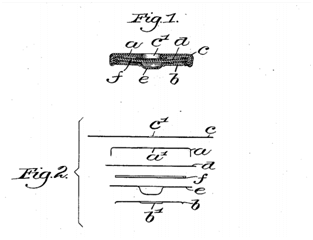
While Lougee does not specify she used celluloid as this filling, there are two possibilities for why Whitehead & Hoag purchased her patent.
The first is that she was in fact using celluloid as a cover over the cloth.
While she does not explicitly name celluloid as the material being used for her button, there have been multiple claims crediting her with the first use of celluloid on a button. Fisher’s (2001) book The Guide to United States Popular Culture states that “a patent was granted to Amanda Lougee of Boston for a clothing button with a textile surface covered with a thin layer of celluloid.” This same statement can be found on a blog post about campaign buttons on the United States House of Representatives “History, Art & Archives” webpage.
The second option is that Whitehead & Hoag Co. wanted ownership of her patent because of the use of a non-metallic material to strengthen buttons.
Because Lougee’s patent doesn’t specify the material being used, this option seems far more likely. As Ted Hake (1986) notes in his history of Whitehead & Hoag Co., the company purchased Lougee’s patent “to protect their other claims,” implying that her patent touched on button technology that they were already working on. While there is the possibility that she was using celluloid, it’s the use of something other than metal and cloth to fabricate the button that makes the invention unique.
While we might not have the answer to which option is correct, what we do know is that Lougee’s patent, along with two later patents by Adams, were featured on Whitehead & Hoag Co.’s buttons from 1896-1901. The company’s back papers list Lougee’s patent alongside Adams’s jewelry patent granted April 14, 1894, and his pinback button patent granted on July 21, 1896.
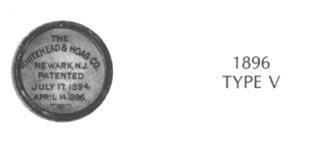

Whether or not her patent included the use of celluloid, it's clear that Amanda Lougee is an important person in pinback button history. We might consider National Pinback Button day to be on July 21, the day Adams was granted his patent, but Lougee’s contribution to its creation also needs to be celebrated. Without her invention, we might not have the same pinback buttons we see today, and that deserves more than a one line blurb in the history books.

Like Fruit Cake? Try Amanda Lougee’s recipe!
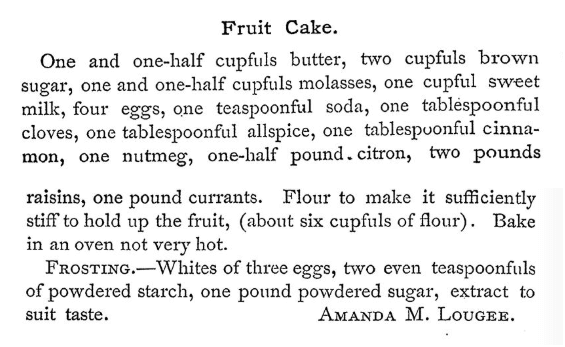
Resources
Art. (2013, May 16). The Life and Times of a Campaign Button. Retrieved from https://history.house.gov/Blog/2013/May/5-16-Campaign_Buttons/
Fischer, R. (2001). Political Advertising. In R. B. Browne & P. Browne (Eds.), The Guide to United States Popular Culture (pp. 618–621). Madison, WI: The University of Wisconsin Press.
Goldberg, H. (2008). So You Think You Know About Button History? Keynoter, 2008(2-4), 91. Retrieved from https://archive.org/details/keynoter2008amer_0/page/90
Hake, T & King, R. (1986). Dating Celluloid Buttons. In Collectible Pin-Back Buttons 1896-1986 (pp. 300–309). York, PA: Hake's Americana & Collectibles Press.
Lougee, A. M. (1890). Fruit Cake. In H. A. Burr (Ed.), The Woman Suffrage Cookbook (pp. 89–90). Boston, MA: Mrs. Hattie A Burr.
Lougee, A, M. (1894). Covered Button. U.S. Patent No. 523,149. Washington, DC: U.S. Patent and Trademark Office.
Scott, A. (n.d.). Biographical Sketch of Amanda Melvina Lougee. Retrieved from https://documents.alexanderstreet.com/d/1009638341
Scarmuzzi, P. (2017, April 10). McKinley First to Use Campaign Pins to Spread Message. Retrieved from https://www.tribtoday.com/news/local-news/2017/04/mckinley-first-to-use…
Willard, F. E., Winslow, H. M., & White, S. E. J. (1897). Occupations for Women: a Book of Practical Suggestions, For the Material Advancement, the Mental and Physical Development, and the Moral and Spiritual Uplift of Woman. Cooper Union, NY: The Success Company. Retrieved from https://books.google.com/books/about/Occupations_for_Women.html?id=SGQu…
Photo Credits
Amanda Lougee Portrait
Sammarco, A. M. (1996). Hyde Park. Charelston, SC: Arcadia Publishing. Retrieved from https://books.google.com/books?id=Md83WCuXnUwC&q=lougee#v=onepage&q&f=f…
Clifton Manufacturing Company
Engelhardt, G. W. (1897). Boston, Massachusetts. Boston, MA: G.W. Engelhardt. Retrieved from https://archive.org/details/bostonmassachuse00enge_0/page/222
Amanda Lougee Patent Drawing and Signature
Lougee, A, M. (1894). Covered Button. U.S. Patent No. 523,149. Washington, DC: U.S. Patent and Trademark Office.
Back Papers
Hake, T. & King, R. (1986). Dating Celluloid Buttons. In Collectible Pin-Back Buttons 1896-1986 (pp. 300–309). York, PA: Hake's Americana & Collectibles Press
Fruit Cake
Lougee, A. M. (1890). Fruit Cake. In H. A. Burr (Ed.), The Woman Suffrage Cookbook (pp. 89–90). Boston, MA: Mrs. Hattie A Burr.
Research and text by Chelsea Clark
